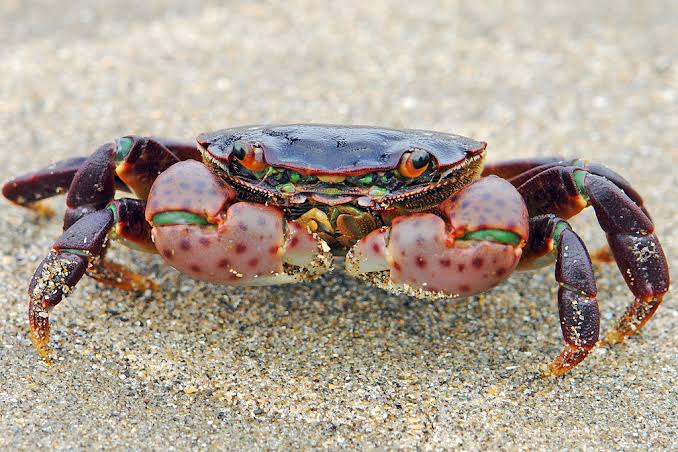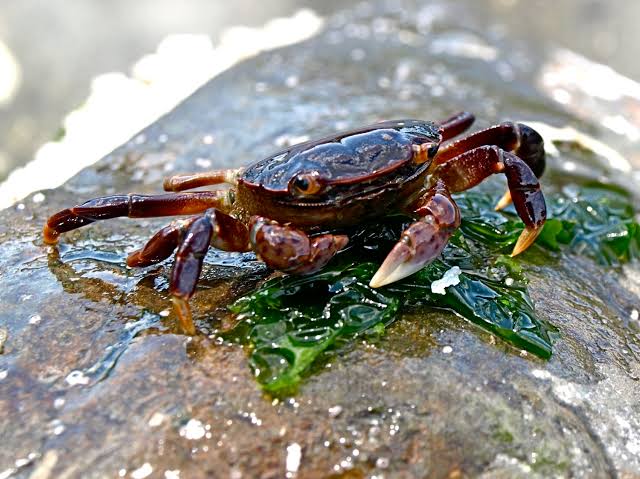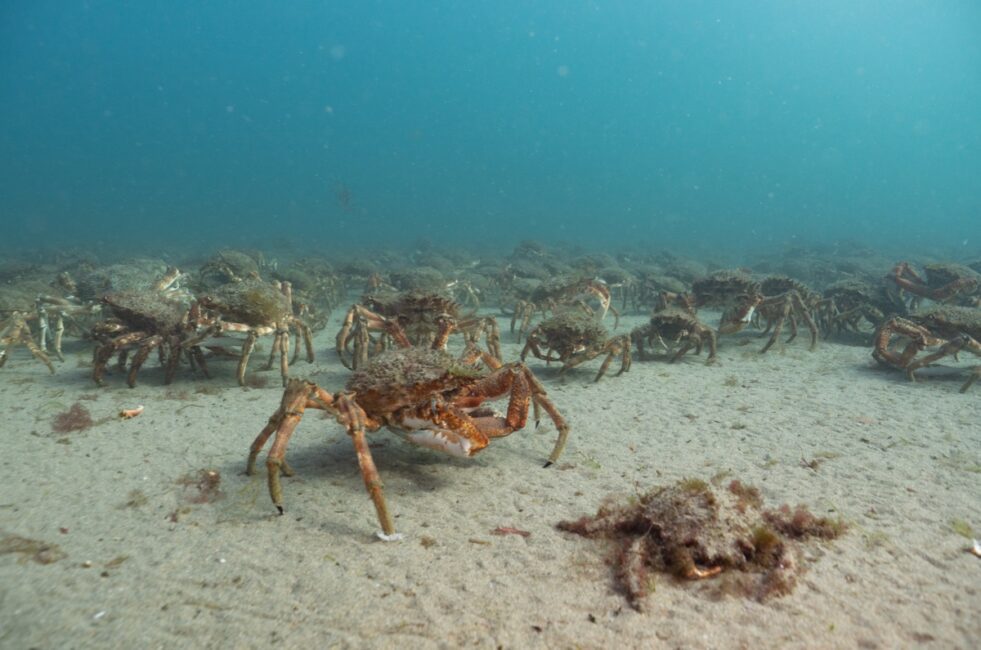Crabs are fascinating creatures found in oceans, rivers, and even on land. These animals belong to the crustacean family, characterized by their tough exoskeletons and jointed limbs. Let’s dive into the world of crabs and explore their intriguing features.
Crabs come in various shapes and sizes, from tiny hermit crabs to large king crabs. One of their distinctive features is their broad, flattened bodies, which are covered by a hard outer shell. This shell, called the carapace, provides protection for the crab’s delicate internal organs.
These crustaceans are renowned for their sideways walking, a distinctive movement that sets them apart from many other sea creatures. This unique walking style is made possible by their jointed legs, allowing them to scuttle along the ocean floor or sandy shores with ease.
Crabs have a remarkable ability to adapt to different environments. Some species are adept swimmers, while others prefer a more terrestrial lifestyle. Hermit crabs, for instance, are known for their habit of finding and using empty seashells as protective homes. This behavior showcases their resourcefulness in utilizing natural materials for shelter.
One of the most iconic features of crabs is their powerful claws, or chelae. These claws serve various purposes, such as capturing prey, defending against predators, and even communication. Male crabs often have larger claws, which they use to attract mates and establish dominance in their social interactions.
Feeding habits among crabs vary, with some being omnivores and others primarily herbivores. Their diet may include algae, small fish, mollusks, and detritus. The diversity in their feeding preferences contributes to the ecological balance of marine and freshwater ecosystems.
Reproduction in crabs is a complex process involving courtship rituals and molting. Female crabs release eggs into the water, where they undergo various developmental stages before hatching into larvae. The survival of crab offspring is often influenced by environmental factors and the availability of suitable habitats.
Crabs play a vital role in marine ecosystems as both predators and prey. They contribute to nutrient cycling by scavenging on decaying matter, and their presence influences the population dynamics of other marine organisms. Additionally, crabs are important for human consumption, making them a valuable resource in various cultures worldwide.
Crabs are captivating creatures with diverse characteristics and behaviors. Their ability to thrive in different habitats, unique locomotion, and crucial role in ecosystems make them a subject of interest for scientists and nature enthusiasts alike. Whether scuttling along the ocean floor or adorning a seafood dinner plate, crabs continue to capture our attention and contribute to the rich tapestry of life in aquatic environments.
Crabs exhibit a wide array of behaviors that add to their intrigue. Some species engage in elaborate courtship dances, involving movements of their claws and body to attract potential mates. These displays are not only fascinating to observe but also highlight the complexity of social interactions within crab populations.
Molting is a crucial aspect of a crab’s life cycle. As they grow, crabs shed their exoskeletons in a process known as molting. This vulnerable period leaves them susceptible to predators, and during this time, crabs often seek shelter until their new exoskeleton hardens. Molting is a necessary step for growth, and the frequency of molting varies among species.
The ecological impact of crabs extends beyond their role in nutrient cycling. Some crabs, like the fiddler crab, are ecosystem engineers. They create burrows in the mud, influencing the structure of coastal habitats and providing shelter for other organisms. This alteration of the environment demonstrates the interconnectedness of marine life and the profound effect that these small creatures can have on their surroundings.
Crab fisheries are an essential part of the global economy, supporting livelihoods and providing a significant protein source for many communities. However, sustainable management practices are crucial to prevent overfishing and ensure the long-term health of crab populations. Conservation efforts are underway to balance human consumption with the preservation of crab habitats and ecosystems.
In some cultures, crabs have symbolic significance and are incorporated into folklore, art, and cuisine. The art of crab fishing has been passed down through generations, with traditional methods reflecting a deep connection between communities and the sea. Celebrations and festivals centered around crab harvesting further emphasize the cultural importance of these crustaceans.
Crabs are not only found in saltwater environments but also in freshwater habitats. Freshwater crabs exhibit their own set of adaptations to life in rivers and lakes. These species face unique challenges and contribute to the biodiversity of freshwater ecosystems. Exploring the diversity of crabs across different habitats adds another layer to our understanding of these captivating creatures.
In addition, crabs captivate us not only with their physical adaptations but also with their behaviors, ecological roles, and cultural significance. As stewards of the marine environment, we must continue to study and appreciate these fascinating creatures, ensuring that our interactions with them are sustainable and respectful of the delicate balance that exists in the world beneath the waves.
Read Also: The History and Origin of Animals
Appearance and Features of Crabs

Crabs exhibit a diverse range of appearances and features, contributing to their remarkable adaptability in various environments. Their most prominent characteristic is the hard exoskeleton, or carapace, which encases their bodies and provides protection. This outer shell comes in an array of colors and patterns, often camouflaging crabs within their surroundings.
The body structure of crabs is notably flattened and broad, helping them move efficiently along the ocean floor or sandy substrates. Jointed appendages, including legs and claws, facilitate their distinctive sideways movement. These limbs are not only crucial for locomotion but also serve multiple functions, such as capturing prey, navigating, and engaging in social interactions.
Crabs are renowned for their formidable claws, or chelae, which come in various shapes and sizes depending on the species. These claws are powerful tools used for defense, feeding, and communication. Male crabs typically have larger and more robust claws, which they use in courtship displays and competitions for mates.
The eyes of crabs are situated on stalks, allowing for a wide range of vision. This adaptation enables them to detect predators and prey from different angles. Interestingly, some species of crabs have evolved with eyes that can see both in and out of the water, showcasing their ability to thrive in diverse habitats.
Many crabs also possess specialized structures for sensing and communication. Antennae play a crucial role in detecting chemical cues in the environment, aiding in locating food and mates. Communication among crabs involves a combination of visual displays, vibrations, and chemical signals, contributing to complex social interactions within their communities.
As crabs grow, they undergo molting, a process in which they shed their exoskeleton to accommodate their increasing size. During molting, crabs are particularly vulnerable, and finding a secure location becomes essential for their survival. The new exoskeleton gradually hardens, providing renewed protection.
In freshwater environments, where some crabs dwell, adaptations to different salinity levels are evident. These adaptations may include modified gills and behavioral strategies to maintain osmotic balance in changing conditions.
The appearance and features of crabs are as diverse as the environments they inhabit. Their exoskeletons, claws, eyes, and sensory structures highlight the intricacies of their adaptations, allowing them to thrive in oceans, rivers, and even on land. These unique characteristics contribute to the allure and ecological importance of these fascinating crustaceans.
Health and Lifespan of Crabs
Crabs, like many living organisms, can face various health issues throughout their lives. One common concern is molting-related complications. Molting is a critical process for growth, but it also leaves crabs vulnerable to predation and environmental stress. Any disruption in the molting process, such as insufficient nutrients or environmental changes, can lead to molting difficulties, impacting the crab’s overall health.
Parasites are another health challenge for crabs. They may be affected by external parasites like barnacles or internal parasites that can compromise their well-being. Parasitic infestations can affect the crab’s ability to feed, move, and reproduce.
Environmental factors, such as pollution and habitat degradation, can significantly impact crab populations. Crabs are sensitive to changes in water quality, temperature, and salinity. Human activities that introduce pollutants into their habitats can result in adverse health effects, affecting not only individual crabs but also entire ecosystems.
Furthermore, overfishing and habitat destruction pose threats to crab populations. Unregulated harvesting practices can lead to population declines, disrupting the natural balance within ecosystems. Conservation efforts are crucial to mitigate these human-induced threats and maintain the health of crab populations.
The lifespan of crabs varies among species. Generally, smaller species tend to have shorter lifespans, while larger species may live longer. Factors such as environmental conditions, predation, and the availability of resources also play a role in determining the lifespan of crabs.
In marine environments, some smaller crab species may only live for a few years, while larger species like king crabs can have lifespans of a decade or more. Freshwater crabs also exhibit diverse lifespans based on their species and environmental conditions.
The ability of crabs to regenerate lost limbs, a process known as autotomy, contributes to their resilience and survival. This mechanism allows crabs to recover from injuries and adapt to their dynamic environments.
Understanding the health issues and lifespan of crabs is essential for conservation efforts and sustainable management practices. By addressing threats to their well-being and preserving their habitats, we can contribute to the longevity and ecological balance of these intriguing crustaceans.
Nutrition and Feeding Mode of Crabs

Crabs showcase a diverse range of feeding modes and dietary preferences, contributing to their adaptability in different ecosystems. Their nutrition and feeding habits play a crucial role in maintaining their health and influencing the balance of marine and freshwater environments.
1. Omnivorous Diet: Many crabs are opportunistic omnivores, meaning they consume both plant and animal matter. Algae, plankton, detritus, small fish, mollusks, and carrion are common components of their diet. This versatility allows crabs to exploit various food sources based on availability and environmental conditions.
2. Herbivorous Crabs: Some crab species are primarily herbivorous, relying on algae and plant material as their main food source. These crabs play a role in controlling algal growth in ecosystems, contributing to the balance of underwater flora.
3. Carnivorous Behavior: Certain crabs exhibit carnivorous behavior, actively hunting and capturing prey. Their strong claws are instrumental in securing small fish, invertebrates, and even other crabs. This predatory behavior is often more pronounced in larger species with powerful chelae.
4. Scavenging: Scavenging is a common feeding mode among crabs. They feed on decaying organic matter and detritus, playing a vital role in nutrient cycling within marine and freshwater ecosystems. This scavenging behavior contributes to the cleanliness of their habitats.
5. Filter Feeding: Some crab species, especially those with specialized appendages, engage in filter feeding. By using modified mouthparts, they filter particles from the water, extracting nutrients and microscopic organisms. This feeding mode is common in crabs inhabiting areas with abundant plankton.
Crabs employ a variety of feeding strategies based on their species, size, and habitat. Their feeding habits are often influenced by seasonal changes, reproductive stages, and environmental factors. As opportunistic feeders, crabs adapt their diet to suit the available resources in their surroundings.
Understanding the nutritional requirements and feeding modes of crabs is essential for their conservation and sustainable management. Human activities, such as overfishing and habitat destruction, can impact the availability of food sources for crabs, highlighting the need for responsible environmental practices to ensure the well-being of these intriguing crustaceans.
Read Also: The Appearance and Features of a Lion
Benefits of Crabs

Crabs offer several ecological, economic, and cultural benefits, making them significant contributors to both marine and freshwater ecosystems and human societies:
1. Ecological Balance: Crabs play a crucial role in maintaining ecological balance by participating in nutrient cycling. Their scavenging and detritivore activities help decompose organic matter, contributing to the overall health of marine and freshwater environments.
2. Population Control: Predatory crabs help control the populations of other marine organisms, such as mollusks and smaller crustaceans. This regulation is essential for preventing overpopulation and maintaining biodiversity within ecosystems.
3. Economic Importance: Commercial and recreational fisheries target various crab species, providing a valuable source of income and employment for communities worldwide. Crabs are a significant seafood resource, contributing to the global economy and supporting livelihoods.
4. Cultural Significance: Crabs hold cultural importance in various societies. They are often featured in folklore, art, and traditional practices. Festivals and rituals centered around crab harvesting demonstrate the cultural significance of these crustaceans in many coastal communities.
5. Research and Education: Studying crabs provides valuable insights into marine biology, ecology, and environmental science. Researchers use crabs as model organisms to better understand aspects of molting, behavior, and adaptations, contributing to broader scientific knowledge.
6. Aquaculture and Fisheries Management: Sustainable crab aquaculture practices help meet the demand for crab products while minimizing environmental impact. Fisheries management strategies aim to ensure the long-term viability of crab populations, balancing human consumption with conservation efforts.
7. Bioturbation and Habitat Engineering: Crabs, particularly burrowing species, contribute to bioturbation—altering sediment structure and nutrient availability. Some crabs, like fiddler crabs, are ecosystem engineers that create burrows, influencing the habitat structure of coastal areas and benefiting other organisms.
8. Food Web Dynamics: Crabs are integral components of marine food webs, serving as prey for various predators. Their interactions within food webs influence the abundance and distribution of other species, contributing to the overall balance of marine ecosystems.
Understanding and appreciating the benefits of crabs are essential for responsible resource management and conservation efforts. Balancing human utilization with sustainable practices ensures the continued well-being of these fascinating crustaceans and the ecosystems they inhabit.
Read Also: Health Benefits of Yoga
